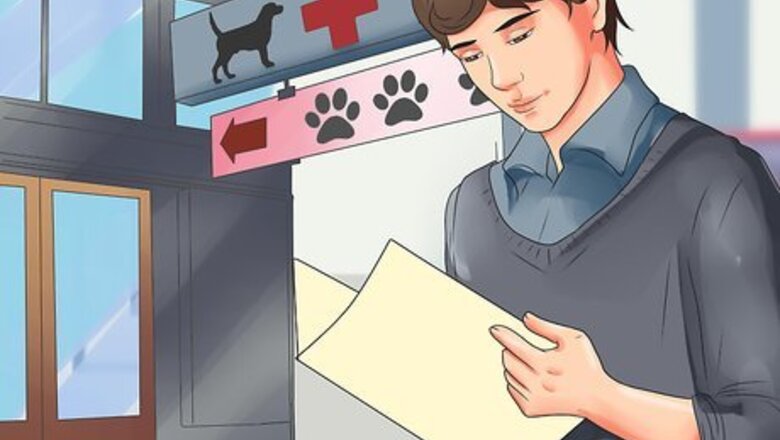
views
Preparing for the Vaccine

Apply for a rabies exemption. Laws regarding rabies vaccines are strict in most states. In order to vaccinate your dog at home, you'll need your vet to apply for a rabies exemption. This is an order that grants you the authority to have the rabies vaccination performed in your home in lieu of a vet's office. Note that this exemption may not be allowed in your state. All 50 US States require a rabies vaccine and the vast majority require dog owners to have the vaccine administered either in a vet's office, at home but under the supervision of a licensed veterinarian, or by animal shelter workers, kennel owners, or other competent individuals who work with dogs professionally. Arizona, Hawaii, Nevada, New York, and North Dakota require rabies vaccinations, but have no specific laws dictating who can perform the vaccine. If you live in one of these states, you may be able to perform the vaccine yourself without supervision of a veterinarian. This is not recommended, unless you have extensive experience in veterinary care, you should hire professional help. Quite a few states allow an individuals to administer the rabies vaccine at home, if supervised by a veterinary professional. The following states allow this: Idaho, Kansas, Maine, Maryland, Minnesota, New Mexico, Pennsylvania, Rhode Island, South Carolina, Tennessee, Texas, Utah, Vermont. However, in other states, be aware that giving the injection yourself may invalidate any rabies certification. If you need proof of rabies vaccine for travel or the like, giving the injection yourself may make it invalid. If your state allows you to administer a vaccine at home, you need your vet to apply for a rabies vaccination exemption. Usually, if your dog has documented behavioral or health issues that make an office visit difficult, your veterinarian will probably be willing to file for an exemption if local laws permit and if you agree to follow proper protocol. If your vet is unwilling, you can find another veterinarian. Veterinarians open to more holistic medications and treatment options might be more willing to file for an extension.
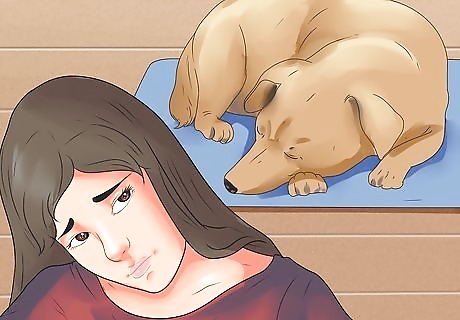
Familiarize yourself with the appropriate time frames to vaccinate for rabies. Timing is important in a rabies vaccination. Giving the vaccination too soon could render the vaccine ineffective and waiting might leave your dog susceptible to the virus. Your puppy should be get the rabies vaccine between 12 and 24 weeks. If you have a puppy, do not vaccinate him before three months of age, as maternal antibodies may interfere with vaccine uptake and prevent it from being effective. Aim to vaccinate early in the morning, at a time when you can monitor your dog for at least an hour to watch for signs of serious allergic reactions. Your dog should get vaccinated every one to three years, depending on the laws in your state.

Acquire the vaccine from a reliable supplier. A vaccine is the biological substance that improves immunity against specific diseases, so a good quality vaccine is necessary for the successful treatment of your dog. Your local veterinarian is the best person to refer you to the best suppliers of rabies vaccines. In fact, as you'll likely have an at-home vet visit you can simply have the veterinarian safely transport the proper vaccine to your home. You can also purchase the vaccine from online sites, but they may be of questionable quality. As certain temperatures can make the vaccine less effective, delivery and storage is tricky. If you do purchase a vaccine online, consult your vet to make sure the supplier is respected in the veterinary community and follow all instructions on the box for safe storage. If you're worried about a reaction and are striving for a more holistic approach to vaccinations, ask your vet about Thimerosol-free vaccines. Thimerosol (mercury) has been linked to more adverse reactions in some dogs and many suppliers manufacture mercury-free vaccines.
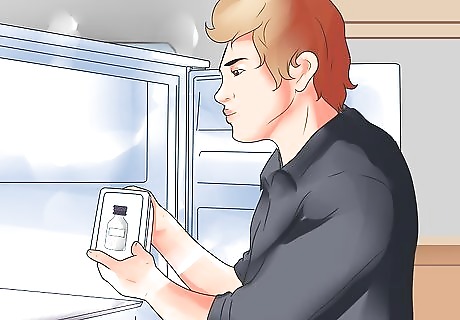
Find a vet who does at-home visits. It is not recommended you perform a rabies vaccination without supervision. Legally your dog will not be considered vaccinated in the vast majority of US states if the vaccine is not administered by a veterinarian professional. Ask your vet if she is willing to do a home visit. Many vets will do so, especially if they know your dog has issues that make an office visit difficult. You can either have your vet administer the vaccine at home or supervise you as you do it yourself. If your vet is unwilling to do home visits, or something in her license prevents this, ask her for a referral to another vet. With your permission, your vet can share your dog's medical records to assure a different veterinarian can safely vaccinate your pet against rabies. Remember, the vast majority of states require veterinary assistance during rabies vaccines. Having a dog that is legally considered unvaccinated has many repercussions. First of all, as rabies vaccines are required in every state, you could face legal penalties that vary from state-to-state. Second, unvaccinated dogs are not permitted in kennels and most animal shelters ban adoption if you have an unvaccinated pet at home.
Administering the Vaccine

Prepare the vaccine. Read the manufacturer's manual to understand all the intricacies of your particular vaccine brand, and inspect the expiration date of your vaccine. With supervision of an at-home vet, properly mix the vaccine. Most rabies vaccines come in the form of a powder and a liquid solvent, which need to be mixed properly before the vaccine can be administered. The manufacturer's label should inform you of proper dosages and you can also ask your at-home vet. First, insert the needle of a clean syringe into the vial of liquid. Draw out the necessary amount and then remove the syringe from the bottle. Inject the liquid into the bottle containing the powder. Make sure all liquid is drained from the syringe before you pull the needle out. Shake the vial well. The powder should completely dissolve. Make sure there are not clumps and there is no powder resting on the bottom of the vial.
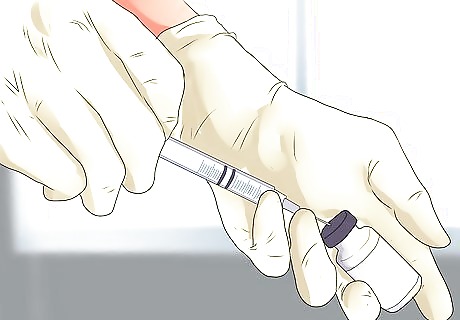
Ready the syringe. Now that the vaccine is properly mixed, you can prepare the syringe for the injection. Reinsert a fresh, clean syringe into the vial. Pull up the plunger until you have drawn the exact amount of vaccine needed. You can ask your at-home vet for help if you're confused about how much of the vaccine you need. Make sure there are no air bubbles. If you notice any air bubbles, empty the vial and try again. You might have to make several attempts before you draw a vaccine clear of air bubbles. Alternatively, if you'd rather have your vet draw the amount you can do that as well. Your vet likely has more experience with these things and might be quicker and more efficient at preparing the syringe.

Give your dog the injection. Once the syringe is prepared, you can vaccinate your dog. The vaccine should be delivered via subcutaneous injection, as this less technically demanding and less likely to harm the dog. Have someone hold the dog still while injecting the vaccine. Pull the skin up from your dog's shoulder blade, creating a "tent" of loose skin. Angle the needle at 90 degrees to the flat tented surface of the skin. Push inward to form a small pocket of skin and slowly push the plunger down until the syringe is empty. If you're not doing the injection, you can hold your dog while your vet performs the vaccination.
Watching for Reactions
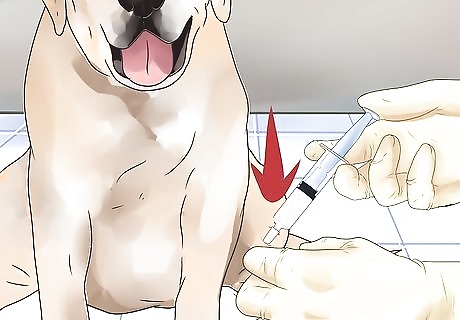
Understand what reactions are normal. Many dogs, even if they're in otherwise good health, may have a reaction to a rabies vaccine. This is usually normal and symptoms should clear up within a week. Allergic reactions are the most common types of reactions. They usually occur during booster shots and after the 2nd or 3rd round. Your dog might become lethargic and show a mild fever and have swelling around the site of the vaccination. Your vet might recommend antihistamines as treatment if the reaction is severe. Severe reactions, while rare, can be fatal. If you live some distance from a vet then you need to be prepared to accept this risk if considering vaccination yourself at home. Local reactions are swelling, redness, and itching about the site of the injection. They occur shortly after a vaccination and are usually not serious. They tend to pass within a few weeks. Systemic reactions are things like fever, lethargy, and loss of appetite. They are common, appear shortly after an injection, and tend to pass within a few days. A serious reaction will occur within 10 to 30 minutes of the injection. The dog may collapse and go into shock and will have pale gums, a racing heart, and may lose consciousness.

Monitor your dog for any effects. Please monitor your dog for a while after vaccination for any adverse effects. Immediately after a vaccine, keep an eye on your dog for about an hour. Bad reactions might occur in this timeframe and medical care might be needed. Be careful handling your dog in the days following a rabies vaccine. He will probably be sore around the site of injection and you'll want to avoid touching this area.
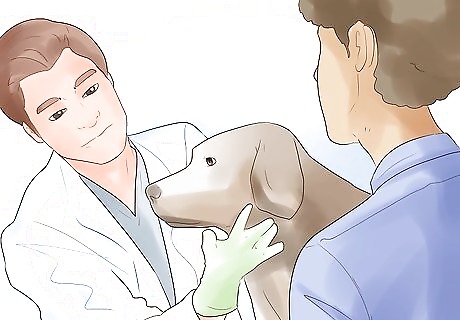
Seek medical care, if necessary. Occasionally, reactions can get quite serious. If you follow proper protocol, this is rare. However, know when medical care might be needed in the event of a serious reaction. Autoimmune hemolytic anemia is an immune response that triggers the release of red blood cells. It is unlikely to occur in response to a rabies vaccine, but not impossible. Signs include lethargy, increased heart rate, difficulty breathing, vomiting, and diarrhea. Autoimmune reactions can be quite serious and warrant medical attention. If you notice any of the above symptoms, seek immediate medical care. If local reactions, such as swelling, or systemic reactions, such as a fever or lethargy, do not go away on their own within a few days, take your dog to see a vet to determine why the reaction is so persistent.
















Comments
0 comment